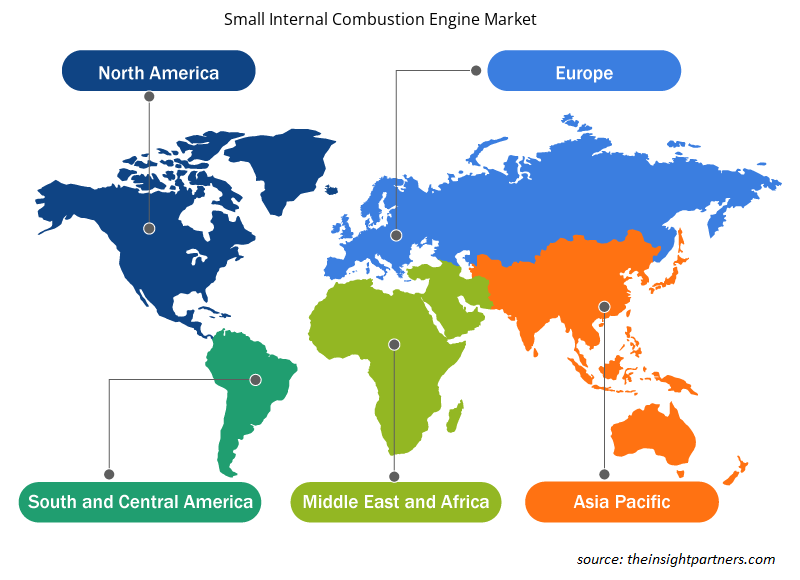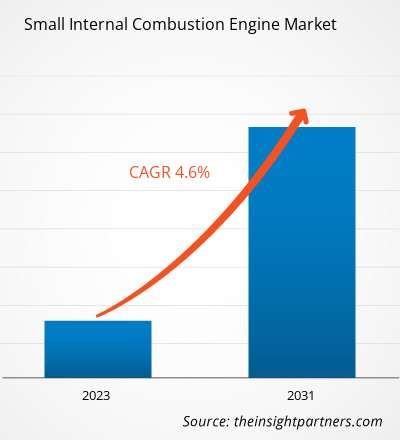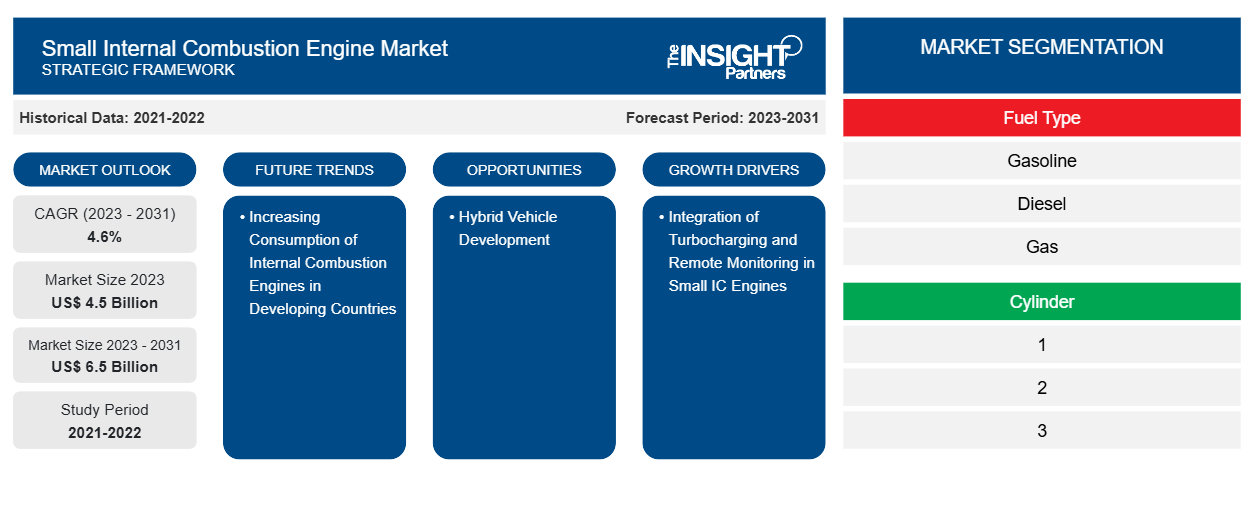小型内燃机市场规模预计将从 2023 年的 45 亿美元增至 2031 年的 65 亿美元。预计 2023-2031 年市场复合年增长率将达到 4.6%。小型内燃机在农业、住宅和建筑应用中的日益普及推动了全球小型内燃机市场的增长。
小型内燃机市场分析
为了减少空气污染,对燃油效率高、低污染排放发动机的需求不断增长,推动了市场增长。全球市场中,电动机在运输、汽车和其他工业应用中的出现是阻碍市场增长的挑战因素之一。尽管内燃机规模较小,但仍有机会通过提高燃油效率来维持增长。为了优化空间和设计,对动力设备小型化的需求日益增长,小型内燃机正在满足这一需求。
小型内燃机市场概况
小型内燃机 (IC) 的发电方式是使用各种燃料,如柴油、汽油和天然气。每种燃料都有一组特定的属性(如密度和挥发性),这些属性决定了其在所需应用中的用途。柴油发动机适用于重型应用或功率要求高的应用。相比之下,汽油小型 IC 发动机对环境的破坏较小,因为它们的排放量低于其他发动机。天然气在小型发动机燃烧技术中的使用有可能解决高排放问题,并有助于制造商满足新的监管规范。南美、亚洲和非洲的小型内燃机 (IC) 的采用率正在增加,而北美和欧洲将在预测期内转向电动机。
定制此报告以满足您的需求
您可以免费定制任何报告,包括本报告的部分内容、国家级分析、Excel 数据包,以及为初创企业和大学提供优惠和折扣
-
获取此报告的关键市场趋势。这个免费样品将包括数据分析,从市场趋势到估计和预测。
小型内燃机市场驱动因素和机遇
发展中国家内燃机消费量不断增加
印度、中国、韩国和巴西等发展中国家在发电、汽车、制造业、交通运输和其他领域更依赖化石燃料。人口增长和电力技术基础设施建设不足是支持小型内燃机市场的主要因素。电动机、电力驱动设备和汽车对消费者来说仍然比内燃机更贵。因此,由于价格限制,各国没有实施任何内燃机禁令,这支持了市场的增长。
小型内燃机的排放标准正在不断提高,制造商也在为此改进解决方案。根据世界银行集团关于电力供应的数据,在南亚,大约 91.6% 的人口可以用电。此外,随着人口的增加,中国和印度等国家基本用途的电力消耗也在增加,原因是这些国家使用化石燃料发电。内燃机在发展中地区的强大主导地位预计将为小型内燃机市场提供先进的解决方案创造机会。例如,根据博世有限公司的数据,到 2030 年,印度销售的 80% 以上的汽车将由内燃机驱动。发展中地区对化石燃料和内燃机的依赖为小型内燃机市场带来了强大的增长机会。
小型内燃机涡轮增压与远程监控的集成
涡轮增压技术已用于汽车内燃机 (IC),以提高中功率发动机的功率容量。小型内燃机制造公司正在研究采用涡轮增压技术,特别是小型发动机的需求。预计在预测期内,涡轮增压技术将引入水泵、人力车、割草机、园林绿化设备、发电机和拖拉机。涡轮增压技术有望在小容量发动机中提供 40-60% 更大的比功率输出。预计涡轮增压器在小型 IC 发动机中的这种集成将在未来几年为市场带来新趋势。
此外,随着几乎所有工业垂直领域的数字化程度不断提高,小型内燃机市场也随着数字连接而发展。例如,Briggs & Stratton, LLC 推出了一款 8 kW Elite Series 发电机,该发电机具有蓝牙连接和通过移动设备进行远程监控的功能。它采用了 InfoHub Portable Power 技术,可以远程监控配备小型内燃机的便携式发电机。此类连接选项增强了用户和机器的界面,这可能会在市场上形成一种新趋势。
小型内燃机市场报告细分分析
有助于小型内燃机市场分析的关键部分是燃料、气缸、功率输出和最终用户。
- 根据燃料类型,小型内燃机市场分为汽油、柴油、天然气(CNG、LPG、LNG)。2023 年,汽油部分占据了较大的市场份额。
- 根据气缸类型,小型内燃机市场分为 1、2、3 和 4。1 缸发动机在 2023 年占据了更大的市场份额。
- 根据功率输出,市场细分为 1-5 kW、6-10 kW、11-20 kW。2023 年,11-20 kW 细分市场将占据市场主导地位。
- 根据最终用户,市场分为发电、制造、石油和天然气、运输和其他。运输部门在 2023 年占据了更大的市场份额。
小型内燃机市场份额按地区分析
小型内燃机市场报告的地理范围主要分为北美、欧洲、亚太、中东和非洲、南美五个区域。
2023 年,亚太地区将主导小型内燃机市场。印度和中国是亚太地区领先的内燃机制造国。发展中国家(尤其是印度和中国)的可支配收入不断增加,为小型内燃机(如发电机、工业发动机、两轮车和电动工具)带来了庞大的客户群,从而推动了小型内燃机市场的增长。中国是内燃机的主要制造中心,而印度和日本也被认为是该地区增长的重要贡献者。
亚太地区各国的特点是大量生产制造、发电和其他工业机械所需的小型内燃机。由于拥有大量熟练的人力资源,印度和中国的制造公司数量不断增加,推动了小型内燃机市场的增长。两轮车销量的增加和发动机燃料来源的进步支持了市场的增长。此外,由于该地区人口的增加和各国相对较低的经济能力,促进了内燃机而不是电能的采用。
小型内燃机市场区域洞察
Insight Partners 的分析师已详细解释了预测期内影响小型内燃机市场的区域趋势和因素。本节还讨论了北美、欧洲、亚太地区、中东和非洲以及南美和中美洲的小型内燃机市场细分和地理位置。

- 获取小型内燃机市场的区域具体数据
小型内燃机市场报告范围
| 报告属性 | 细节 |
|---|---|
| 2023 年的市场规模 | 45亿美元 |
| 2031 年市场规模 | 65亿美元 |
| 全球复合年增长率(2023 - 2031) | 4.6% |
| 史料 | 2021-2022 |
| 预测期 | 2023-2031 |
| 涵盖的领域 |
按燃料类型
|
| 覆盖地区和国家 |
北美
|
| 市场领导者和主要公司简介 |
|
小型内燃机市场参与者密度:了解其对业务动态的影响
小型内燃机市场正在快速增长,这得益于终端用户需求的不断增长,这些需求源于消费者偏好的不断变化、技术进步以及对产品优势的认识不断提高等因素。随着需求的增加,企业正在扩大其产品范围,进行创新以满足消费者的需求,并利用新兴趋势,从而进一步推动市场增长。
市场参与者密度是指在特定市场或行业内运营的企业或公司的分布情况。它表明相对于给定市场空间的规模或总市场价值,有多少竞争对手(市场参与者)存在于该市场空间中。
在小型内燃机市场运营的主要公司有:
- 卡特彼勒公司
- 川崎重工业公司
- 三菱重工业公司
- 利勃海尔
- 洋马控股公司
- 有限公司
免责声明:上面列出的公司没有按照任何特定顺序排列。

- 了解小型内燃机市场顶级关键参与者概况
小型内燃机市场新闻及最新发展
小型内燃机市场通过收集一手和二手研究后的定性和定量数据进行评估,其中包括重要的公司出版物、协会数据和数据库。以下是小型内燃机市场的发展和战略列表:
- 2023 年 3 月,塔塔康明斯绿色能源解决方案公司建立了用于中型和重型商用车的氢燃料内燃机制造厂。该工厂将加强该公司在印度市场的地位和影响力。
- 2021 年 1 月,卡特彼勒船舶签署协议,为美国海军新组建的六艘 YT 808 级拖船舰队提供船用发动机。
小型内燃机市场报告范围和交付成果
“小型内燃机市场规模和预测(2021-2031)”报告对以下领域进行了详细的市场分析:
- 范围内所有主要细分市场的全球、区域和国家层面的市场规模和预测
- 市场动态,如驱动因素、限制因素和关键机遇
- 未来的主要趋势
- 详细的波特五力分析
- 全球和区域市场分析涵盖关键市场趋势、主要参与者、法规和最新市场发展
- 行业格局和竞争分析,涵盖市场集中度、热点图分析、知名参与者和最新发展
- 带有 SWOT 分析的详细公司简介
- 历史分析(2 年)、基准年、预测(7 年)及复合年增长率
- PEST和SWOT分析
- 市场规模、价值/数量 - 全球、区域、国家
- 行业和竞争格局
- Excel 数据集
近期报告
客户评价
购买理由
- 明智的决策
- 了解市场动态
- 竞争分析
- 客户洞察
- 市场预测
- 风险规避
- 战略规划
- 投资论证
- 识别新兴市场
- 优化营销策略
- 提升运营效率
- 顺应监管趋势























 获取免费样品 - 小型内燃机市场
获取免费样品 - 小型内燃机市场